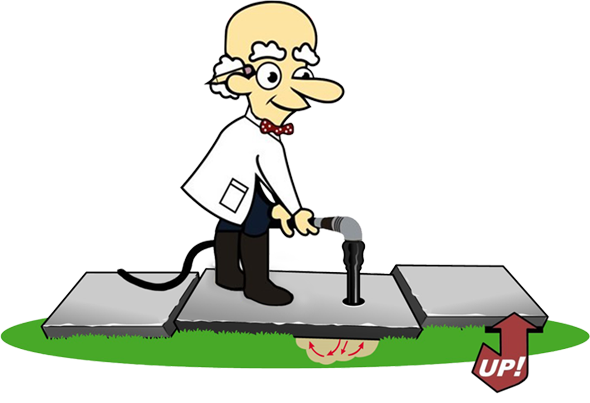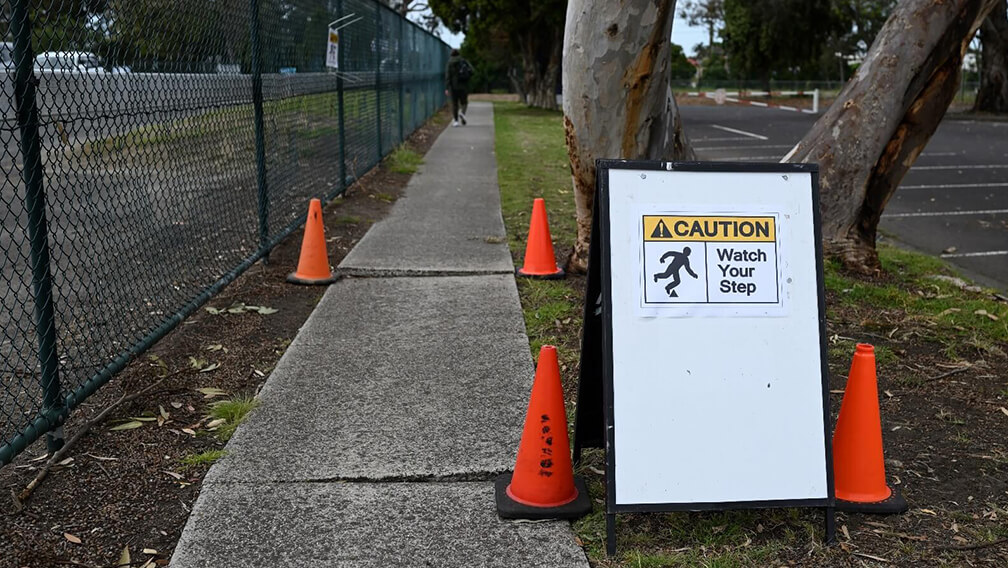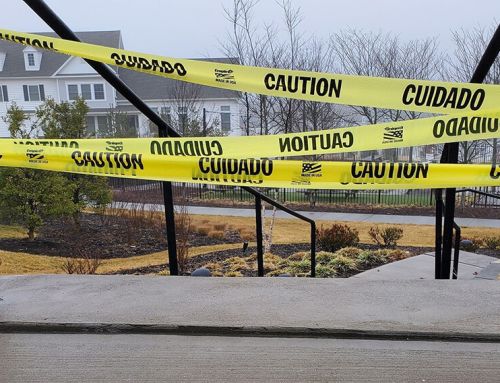IN THIS ARTICLE
Discover the Best Methods to Fix Uneven Concrete Sidewalks as A Home or Business Owner in New Jersey
Is that uneven sidewalk outside your home or business causing trips and falls?
An uneven sidewalk isn’t just an eyesore; it’s a serious safety hazard and can even lower your property’s value. For homeowners across the cities of NJ, from Jersey City toTrenton, dealing with sinking or settled concrete sidewalks is a common problem. But don’t worry – at Concrete Chiropractor, we specialize in fixing them effectively and for good.
Uneven sidewalks not only detract from the aesthetic appeal of a property but also pose significant safety hazards. Property owners are responsible for maintaining public sidewalks in many jurisdictions, making it crucial to address any unevenness promptly. This comprehensive guide will explore proven methods for repairing uneven sidewalks.
What Makes Concrete Sidewalks Uneven?
Sidewalks become uneven for a few main reasons. Understanding why your concrete is sinking helps us pick the best fix for you.
Soil Washout and Erosion:
This is a major problem in New Jersey, especially with our changing weather. When water from heavy rains or melting snow seeps into cracks in your sidewalk, or even through the joints between slabs, it can slowly wash away the soil or dirt beneath.
Imagine water flowing under the concrete, carrying away tiny bits of earth. This creates empty spaces or “voids.” Without solid support, the concrete slabs then sink into these empty spots.
Our state has many different types of soil, from the sandy grounds near the Shore towns that drain quickly but can shift, to the more clay-heavy soils found in areas like Princeton that can hold water and expand or shrink.
These varied soil types react differently to moisture, which can also lead to uneven settling over time.
Tree Roots:
As trees grow, their roots spread outwards and downwards to find water and nutrients. If a tree is planted too close to a sidewalk, its roots will continue to expand right underneath the concrete slabs. As these roots thicken over the years, they exert immense pressure, slowly pushing the heavy concrete upwards.
This creates bumps, cracks, and hazardous uneven sections. This problem is very common in older, tree-lined neighborhoods across many cities in New Jersey, where the roots of mature trees have had decades to grow and impact nearby sidewalks.
Poor Soil Compaction:
Before concrete is poured, the ground underneath must be properly leveled and packed down tightly. This is called soil compaction. If the soil isn’t compacted well enough, it leaves hidden air pockets or loose areas beneath the surface.
Over time, gravity, foot traffic, and water can cause this loose soil to settle, compress, or even wash away. This might not happen right away; sometimes, it takes months or even years for these issues to appear.
When the ground settles unevenly, the concrete slabs above it will also shift, tilt, and sink.
Heavy Loads:
Sidewalks are designed to be strong, but they are built mainly for people walking. Often, they face much heavier burdens than they were made for.
Constant heavy traffic from delivery trucks, garbage collection vehicles, utility company vans, or even cars illegally parked on the sidewalk can put too much stress on the underlying soil and the concrete itself.
This repeated pressure can exceed what the ground underneath can support, leading to the soil breaking down and the concrete cracking or sinking. This is a common issue for sidewalks along busy streets or those that serve commercial properties.
How to Fix Uneven Sidewalks: What Works and What Doesn’t
When you have an uneven sidewalk, you have a few options. It’s important to know which fixes truly solve the problem and which are just temporary patches.
1. Concrete Grinding: A Cost-Effective DIY Solution
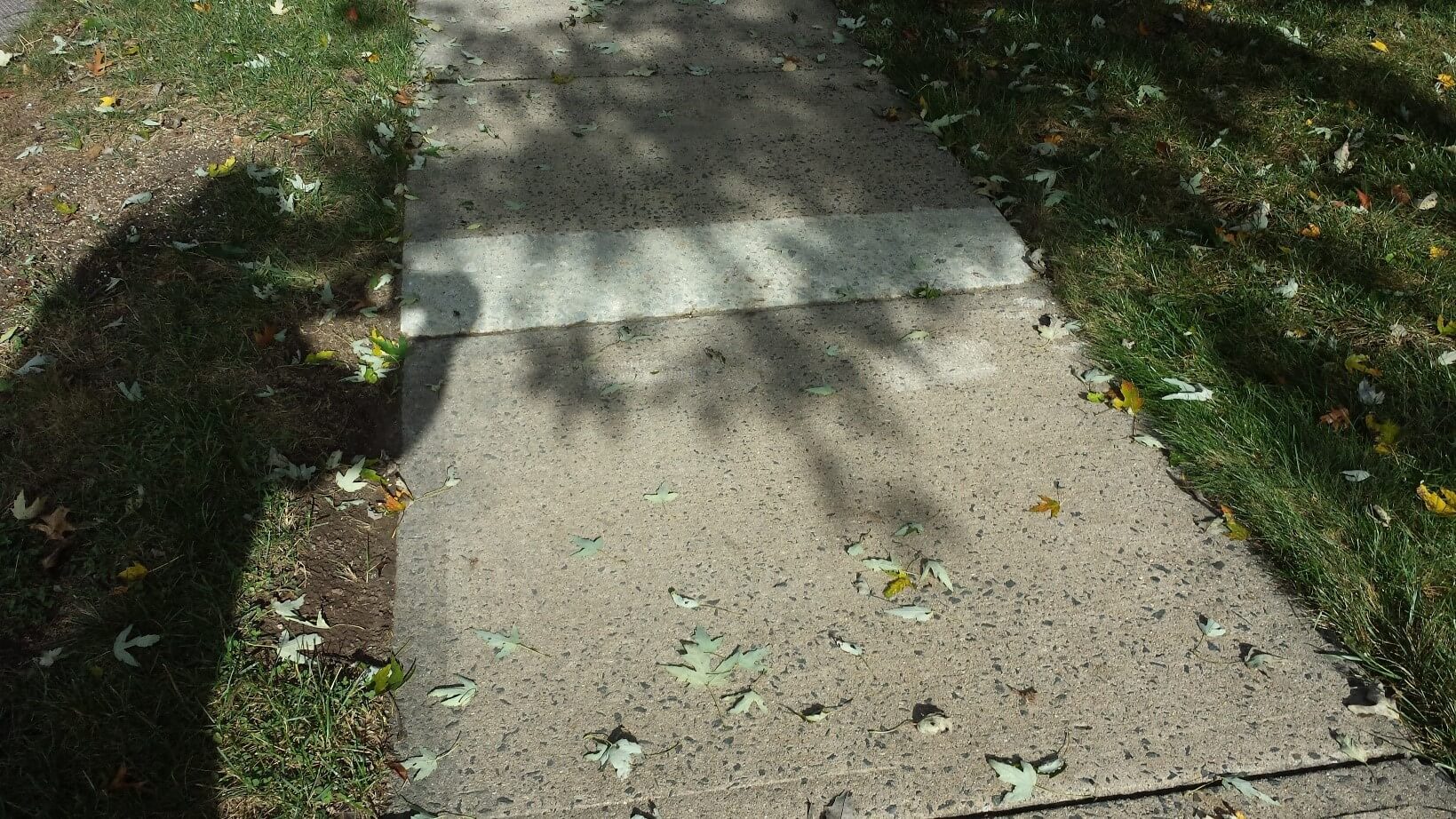
Concrete grinding is a practical and cost-effective solution to fix sidewalk minor unevenness, typically less than 1.5 inches in difference. This method involves shaving down lifted portions of slabs, effectively leveling the surface, and minimizing trip hazards.
Grinding down the higher side of an uneven concrete slab can remove a trip hazard. However, this method thins your concrete, making it weaker in that spot. It also creates a slope that can look strange and, most importantly, it doesn’t fix why the concrete sank in the first place. The ground underneath is still unstable.
This option is most suitable for areas where aesthetics is not a primary concern.
For small sidewalk joints, you can use a handheld grinder. However, for larger sidewalk grinding jobs, hiring professionals with the appropriate tools is recommended.
Here is how DIY sidewalk grinding is done:
- Gather the Necessary Tools and Equipment:
- Handheld grinder
- Diamond grinding wheel or abrasive stones suitable for concrete
- Dust mask
- Safety glasses
- Ear protection
- Gloves
- Knee pads
- Broom or vacuum for cleaning up dust
- Assess the Sidewalk:
- Inspect the sidewalk for raised edges, cracks, or uneven areas. Mark the areas that need grinding.
- Start Grinding:
- Begin grinding at one end of the sidewalk joint and work your way systematically to the other end.
- Move the grinder in a back-and-forth or circular motion to ensure even grinding.
- Overlap each pass to avoid leaving unprocessed areas.
- Keep the Grinder Moving:
- Avoid stopping in one spot for too long, as this can create uneven surfaces.
- Periodically stop and inspect the ground surface to ensure you achieve the desired level and smoothness.
- You might have to use the grinder several times on the sidewalk to get the desired outcome.
If you’re unsure or if the job is large, it’s advisable to seek advice from experts or hire experienced contractors. These professionals specialize in concrete grinding.
2. Professional Concrete Leveling is Your Best Choice
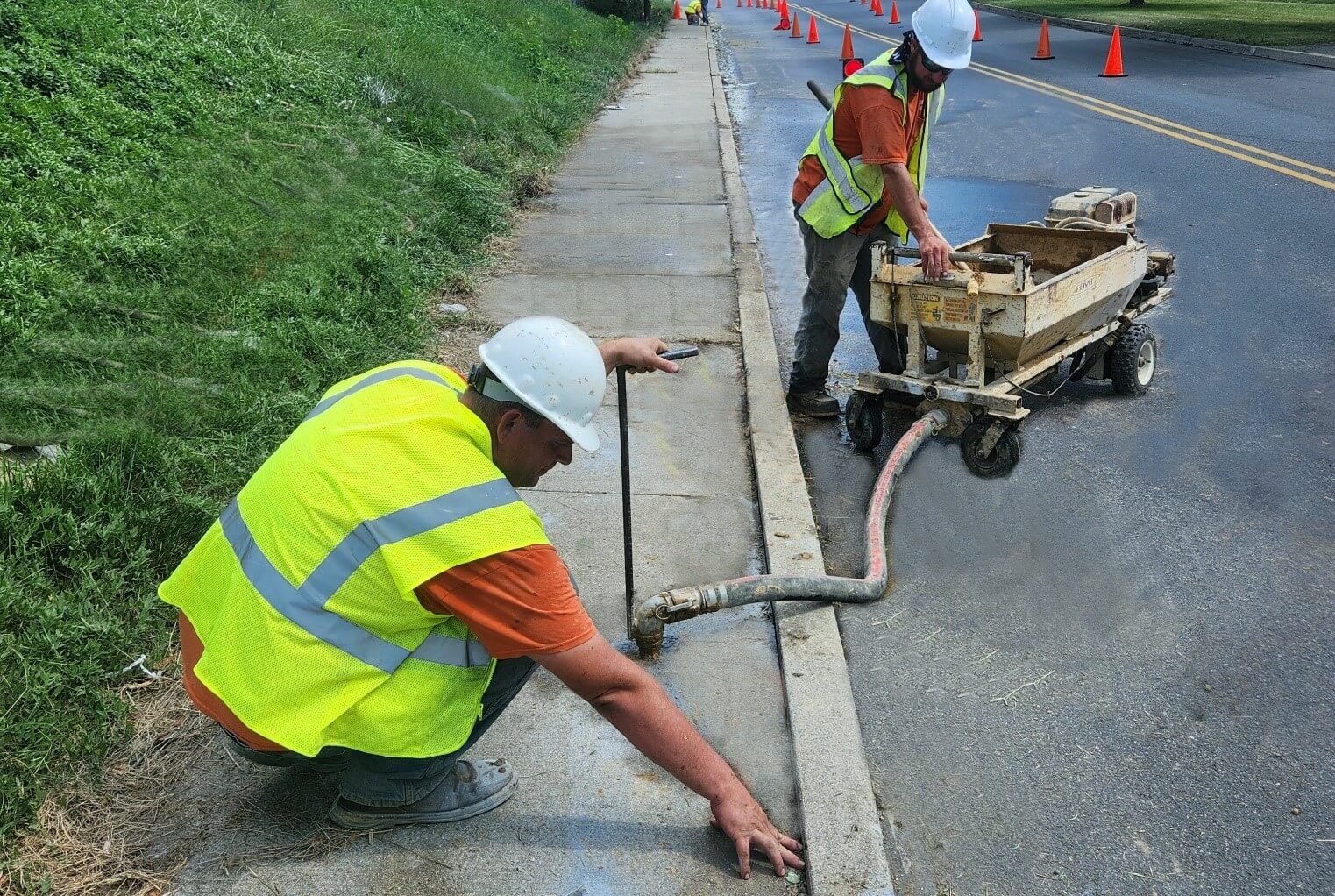
When you have an uneven sidewalk, you need a solution that truly lasts. While patching or grinding might seem like quick fixes, they don’t solve the real problem. For a lasting repair, professional concrete leveling, also known as mudjacking or slab jacking, is by far the most effective and efficient choice.
At Concrete Chiropractor, we don’t just repair uneven sidewalks; we specialize in precisely lifting and stabilizing them. We are the leading experts in this method for homeowners and businesses in NJ and Eastern PA.
Here’s why our approach is the superior solution:
1. Fixes the Real Problem, Permanently:
The main reason your sidewalk is uneven is because the ground underneath has shifted or washed away, leaving empty spaces, or “voids.” Instead of just patching the surface or grinding down the high spot, we go to the source of the issue.
We pump a special material – a mixture of limestone, cement, and water – directly beneath the sunken slab. This strong, stable mixture fills those empty voids, firmly supporting the concrete.
As it fills the space, it gently and precisely lifts the concrete slab back to its original, level position. This means we don’t just hide the problem; we fix the underlying cause to ensure a stable, lasting repair.
2. Cost-Effective Savings:
Tearing out and replacing an entire sidewalk can be very expensive, involving demolition, hauling away old concrete, and buying new materials. Concrete leveling is often 50-70% more affordable than full replacement.
We save you money by using your existing concrete and focusing only on the areas that need lifting. Our efficient process means less labor and material costs for you.
3. Less Invasive, More Respect for Your Home:
Traditional concrete replacement involves heavy equipment, loud jackhammers, and tearing up your lawn or landscaping. With our mudjacking method, we only need to drill a few small holes in your concrete – typically about the size of a dime or quarter.
Through these small holes, we inject our lifting material. This means minimal mess, very little noise, and no need to disrupt your beautiful yard or garden.
Our skilled technicians work cleanly and efficiently, protecting your property throughout the process.
4. Fast & Convenient Use:
One of the biggest advantages of concrete leveling is how quickly your sidewalk becomes usable again.
While new concrete takes days or even weeks to fully cure before it can be walked on or driven over, a mudjacked sidewalk is usually ready for light use within hours of our repair.
This means your daily routine is barely interrupted, whether it’s your morning walk or business operations. We understand your time is valuable, and our goal is to get your sidewalk safe and usable as quickly as possible.
5. Durable & Long-Lasting Results:
Our repairs are designed to stand the test of time. By filling the voids and stabilizing the ground underneath, we provide a solid foundation for your concrete that prevents future sinking in that spot. The material we inject is strong and durable, meant to last for many years.
Our extensive experience lifting concrete across all types of properties in New Jersey means we understand the specific challenges of our local climate and soil conditions, ensuring a high-quality, long-lasting repair that you can rely on.
6. Eco-Friendly Solution:
Choosing concrete leveling is also a smart choice for the environment. By repairing and reusing your existing concrete slabs, you avoid contributing to landfill waste.
Replacing a sidewalk generates tons of concrete debris. Our method significantly reduces construction waste and the need for new concrete production, which helps lower carbon emissions.
We are committed to offering sustainable solutions that benefit both your wallet and the planet.
At Concrete Chiropractor, we don’t just lift concrete; we restore stability, safety, and peace of mind. Our proven mudjacking technique and dedication to quality make us the top choice for fixing uneven sidewalks across NJ Areas.
3. Adding Extra Concrete: A Temporary Fix
Adding extra concrete or patching compound is an option for a quick and cost-effective solution, especially for more minor trip hazards.
However, it’s essential to recognize that this method is often temporary, as the new compound may struggle to bond completely with the existing slab, leading to potential chipping and cracking.
If you decide to do a DIY sidewalk patch as a method of sidewalk repair, here is a step-by-step guide:
Materials and Tools:
- Safety Gear:
- Gloves
- Safety glasses
- Dust mask
- Tools:
- Chisel and hammer or a concrete saw
- Wire brush
- Broom
- Pressure washer
- Concrete patch mortar product (without stone) with bonding agents for adhesion
- Trowel and edging tool
- Wooden float or sponge
Preparation:
Wear safety gear to protect yourself from dust and debris. Also, make sure the weather is suitable for the repair. Avoid extremely hot or cold conditions.
Clean the Area:
- Remove loose or deteriorated concrete using a chisel, hammer, or concrete saw.
- Use a wire brush to clean the area thoroughly.
- Rinse the area with a pressure washer to remove any remaining debris and let dry with no standing water.
Patching:
- Mixing the Concrete Patch:
- Follow the manufacturer’s instructions for mixing the concrete. Repeat: Use a mix with bonding agents for better adhesion.
- Moistening the Area:
- Dampen the repair area with water to surface saturated dry (no standing water). This helps prevent the existing concrete from absorbing water from the new mix too quickly.
- Applying the Concrete:
- Mix a slurry of the cement product and scrub a coat into the concrete repair area to help the patch adhere.
- Maintain all sidewalk joints with a piece of wood or expansion joint. Do not “bridge” the concrete repair from one slab to another, as slab movement will cause the patch to fail.
- Use a trowel to apply the mixed concrete to the damaged area. Ensure it is level with the surrounding concrete. Edge the patch once it is firm enough.
- Smoothing and Shaping:
- Once the patch is firm but not hard, use a wooden float or damp sponge to smooth the surface of the patch.
- Reshape the edges with an edging tool to match the surrounding concrete.
- Curing:
- In warm temperatures, cover the patch with a damp cloth or use curing compounds per product instructions.
Following these steps and using quality materials can create a long-lasting sidewalk cement patch repair. Keep in mind that proper preparation, application, and curing are crucial for the durability of the repair.
Concrete Sidewalk Replacement: Comprehensive Yet Expensive
Concrete replacement is the most comprehensive and expensive solution for uneven sidewalks. This approach is warranted in cases where slabs are severely cracked or crumbling, or substantial changes to the sidewalk’s shape or functionality are desired. Factors such as tree roots lifting slabs too far out of place may also necessitate complete replacement.
Despite its effectiveness, concrete replacement comes with risks, including potential issues with concrete batches and disruption to lawns and landscaping.
Tips for Maintaining Uneven Sidewalk Slabs:
- Trees Next to Sidewalks: Avoid planting trees near sidewalks as their roots can grow and damage the sidewalk. Use root barriers when planting.
- Flexible Concrete Caulk: Use flexible concrete caulk for large concrete cracks or open joints to prevent water seepage under the sidewalk, reducing the risk of settling and damage due to freeze-thaw cycles.
- Eliminate Erosion Sources: Address water flow issues from downspouts, leaky gutters, and poor drainage to prevent soil erosion that can lead to uneven sidewalks.
When to Call a Professional for Your Uneven Sidewalk
It can be hard to know when to call in the experts. Here are clear signs that your uneven sidewalk needs professional attention from us:
- Big Height Differences: If one part of your sidewalk is more than an inch higher or lower than the next, it’s a serious trip hazard.
- Large or Spreading Cracks: While small cracks happen, large or growing cracks often mean the slab is moving and settling.
- Multiple Uneven Sections: If more than one part of your sidewalk is sinking, it points to a bigger issue with the ground underneath.
- Water Pooling: If you see water collecting on or near your foundation because of an uneven sidewalk, it can lead to bigger problems for your home.
- Safety Concerns: Any area where you or others might trip or fall needs a proper fix.
If you notice any of these signs on your sidewalk, whether you’re in Middlesex County or Ocean County, it’s time to call in the experts.
Trying to fix complex concrete problems yourself can be unsafe and might even lead to bigger, more expensive issues down the road.
Get Your Uneven Sidewalk Fixed anywhere in New Jersey Fast!
Don’t let an uneven sidewalk be a safety risk or an eyesore any longer. As an experienced and trusted expert in concrete leveling in NJ cities. We solve your uneven sidewalk problems safely and effectively, restoring your property’s value and curb appeal.
We offer free, no-obligation estimates for homeowners and businesses across the state. Whether you’re dealing with a hazardous sidewalk in Clifton, Paterson, or anywhere from North Jersey to the Shore, we’re here to help.
Call us today for a free inspection and quote, or fill out our online form to learn how we can help your home or business.
- How We Raised a Sunken Concrete Walkway in Sewell, NJ - November 20, 2025
- Carbon Fiber Foundation Repair: All You Need to Know - November 20, 2025
- 5 Common Causes of Concrete Porch Collapse (and How to Prevent It) - November 20, 2025
